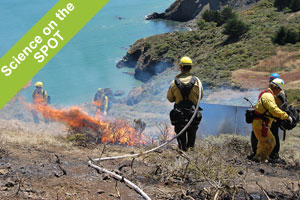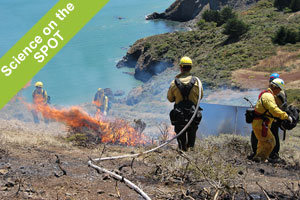 On a glorious sunny August morning I found myself in a parking lot in the Marin headlands attending in a pre-burn fire crew meeting. While most of my attention was allocated towards snapping photos of the fire crews, I picked up a few words from the burn master Roger Wong. My ears perked up when he described how we should flee down hill in the unlikely event that the flames escaped their control. Good to know.
On a glorious sunny August morning I found myself in a parking lot in the Marin headlands attending in a pre-burn fire crew meeting. While most of my attention was allocated towards snapping photos of the fire crews, I picked up a few words from the burn master Roger Wong. My ears perked up when he described how we should flee down hill in the unlikely event that the flames escaped their control. Good to know.
He went on to inform the crews where the ambulance would pick up casualties in the event of an accident, and that helicopter extraction was standing by in case anyone was badly burned. The crew of about 30 firefighters appeared completely unfazed, just another day at the office. The divide between these fairly heroic-looking fire crew members and myself was exaggerated by the fact that I was provided with the last available set of fireproof clothing, which was far too large for me. I also had to figure out how to wear my bulky headphones and a bright orange hard hat simultaneously.
It was my first day out as a primary shooter for QUEST’s Science on the SPOT. As the summer intern I was just happy to be out in the field producing content, instead of being back in an office logging tapes and making coffee the way so many productions require of their interns. I had just moved back to the bay area from Bozeman, where I had spent the last three years as a graduate student in Montana State University’s MFA program in Science and Natural History Filmmaking. A few months earlier I had met QUEST Producer Chris Bauer at the San Francisco Ocean Film Festival. We both had films screening the festival, and between screenings I had told him that I was a huge fan of KQED and QUEST. He suggested that as a student I should look into the possibility of interning with QUEST. Now here we were, three months later, about to film a prescribed burn intended to improve habitat quality for endangered Mission Blue Butterflies by increasing the population of their fire disturbance dependent host plant, the Silver Leaf Lupine.
I was very eager to try to impress Chris by getting some great footage of the burn, despite being relatively unfamiliar with the QUEST camera and audio equipment. Compounding my challenge was the bright sun and wind; not ideal conditions for shooting interviews with digital video.
